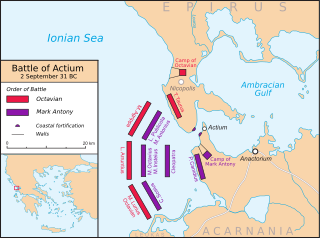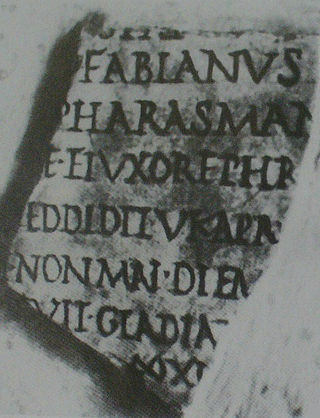
Year 31 BC was either a common year starting on Tuesday, Wednesday or Thursday or a leap year starting on Tuesday or Wednesday of the Julian calendar and a common year starting on Tuesday of the Proleptic Julian calendar. At the time, it was known as the Year of the Consulship of Antonius and Caesar or as Caesar and Messalla. The denomination 31 BC for this year has been used since the early medieval period, when the Anno Domini calendar era became the prevalent method in Europe for naming years.

The 10s decade ran from January 1, AD 10, to December 31, AD 19.

The 40s decade ran from January 1, AD 40, to December 31, AD 49.
AD 1 (I) or 1 CE was a common year starting on Saturday or Sunday, a common year starting on Saturday by the proleptic Julian calendar, and a common year starting on Monday by the proleptic Gregorian calendar. It is the epoch year for the Anno Domini (AD) Christian calendar era, and the 1st year of the 1st century and 1st millennium of the Christian or Common Era (CE).
AD 8 was a leap year starting on Sunday of the Julian calendar. In the Roman Empire, it was known as the Year of the Consulship of Camillus and Quinctilianus. The denomination "AD 8" for this year has been used since the early medieval period, when the Anno Domini calendar era became the prevalent method in Europe for naming years.

100 (C) was a leap year starting on Wednesday of the Julian calendar, the 100th year of the Common Era (CE) and Anno Domini (AD) designations, the 100th year of the 1st millennium, the 100th and last year of the 1st century, and the 1st year of the 100s decade. As of the start of 100, the Gregorian calendar was 2 days behind the Julian calendar, which was the dominant calendar of the time.
Year 40 BC was either a common year starting on Thursday, Friday or Saturday or a leap year starting on Thursday or Friday of the Julian calendar and a common year starting on Friday of the Proleptic Julian calendar. At the time, it was known as the Year of the Consulship of Calvinus and Pollio. The denomination 40 BC for this year has been used since the early medieval period, when the Anno Domini calendar era became the prevalent method in Europe for naming years.

John the Apostle, also known as Saint John the Beloved and, in Eastern Orthodox Christianity, Saint John the Theologian, was one of the Twelve Apostles of Jesus according to the New Testament. Generally listed as the youngest apostle, he was the son of Zebedee and Salome. His brother James was another of the Twelve Apostles. The Church Fathers identify him as John the Evangelist, John of Patmos, John the Elder, and the Beloved Disciple, and testify that he outlived the remaining apostles and was the only one to die of natural causes, although modern scholars are divided on the veracity of these claims.

Mark the Evangelist, also known as John Mark or Saint Mark, is the person who is traditionally ascribed to be the author of the Gospel of Mark. Modern Bible scholars have concluded that the Gospel of Mark was written by an anonymous author rather than an identifiable historical figure. According to Church tradition, Mark founded the episcopal see of Alexandria, which was one of the five most important sees of early Christianity. His feast day is celebrated on April 25, and his symbol is the winged lion.
Year 4 BC was a common year starting on Tuesday or Wednesday of the Julian calendar and a common year starting on Monday of the Proleptic Julian calendar. At the time, it was known as the Year of the Consulship of Sabinus and Rufus. The denomination 4 BC for this year has been used since the early medieval period, when the Anno Domini calendar era became the prevalent method in Europe for naming years.
Year 10 BC was either a common year starting on Tuesday, Wednesday or Thursday or a leap year starting on Tuesday or Wednesday of the Julian calendar and a common year starting on Sunday of the Proleptic Julian calendar. At the time, it was known as the Year of the Consulship of Maximus and Antonius. The denomination 10 BC for this year has been used since the early medieval period, when the Anno Domini calendar era became the prevalent method in Europe for naming years.

Year 50 BC was a year of the pre-Julian Roman calendar. At the time, it was known as the Year of the Consulship of Paullus and Marcellus. The denomination 50 BC for this year has been used since the early medieval period, when the Anno Domini calendar era became the prevalent method in Europe for naming years.
Year 63 BC was a year of the pre-Julian Roman calendar. At the time it was known as the Year of the Consulship of Cicero and Hybrida. The denomination 63 BC for this year has been used since the early medieval period, when the Anno Domini calendar era became the prevalent method in Europe for naming years.
Year 39 BC was either a common year starting on Friday, Saturday or Sunday or a leap year starting on Saturday of the Julian calendar and a common year starting on Saturday of the Proleptic Julian calendar. At the time, it was known as the Year of the Consulship of Censorinus and Sabinus. The denomination 39 BC for this year has been used since the early medieval period, when the Anno Domini calendar era became the prevalent method in Europe for naming years.

Sextilis or mensis Sextilis was the Latin name for what was originally the sixth month in the Roman calendar, when March was the first of ten months in the year. After the calendar reform that produced a twelve-month year, Sextilis became the eighth month, but retained its name. It was renamed Augustus (August) in 8 BC in honor of the first Roman emperor, Augustus. Sextilis followed Quinctilis, which was renamed Julius (July) after Julius Caesar, and preceded September, which was originally the seventh month.
AD 2 (II) or 2 AD was a common year starting on Sunday or Monday of the Julian calendar and a common year starting on Sunday of the proleptic Julian calendar. In the Roman Empire, it was known as the Year of the Consulship of Vinicius and Varus, named after Roman consuls Publius Vinicius and Alfenus Varus, and less frequently, as year 755 AUC within the Roman Empire. The denomination "AD 2" for this year has been used since the early medieval period, when the Anno Domini calendar era became the prevalent method in Europe for naming years.

The Fasti Ostienses are a calendar of Roman magistrates and significant events from 49 BC to AD 175, found at Ostia, the principal seaport of Rome. Together with similar inscriptions, such as the Fasti Capitolini and Fasti Triumphales at Rome, the Fasti Ostienses form part of a chronology known as the Fasti Consulares, or Consular Fasti.

Martius or mensis Martius ("March") was the first month of the ancient Roman year until possibly as late as 153 BC. After that time, it was the third month, following Februarius (February) and preceding Aprilis (April). Martius was one of the few Roman months named for a deity, Mars, who was regarded as an ancestor of the Roman people through his sons Romulus and Remus.
October or mensis October was the eighth of ten months on the oldest Roman calendar. It had 31 days. October followed September and preceded November. After the calendar reform that resulted in a 12-month year, October became the tenth month, but retained its numerical name, as did the other months from September to December.









